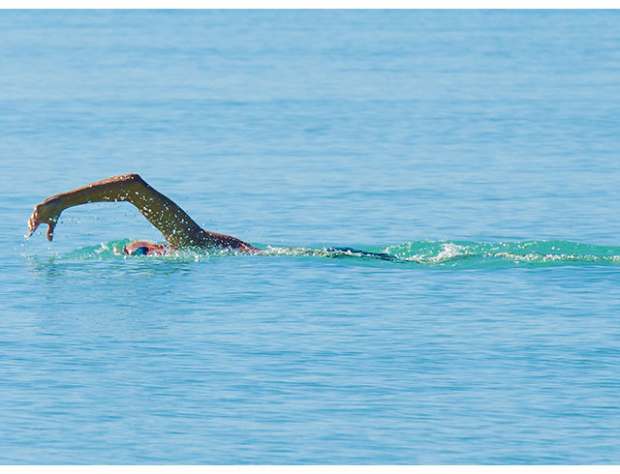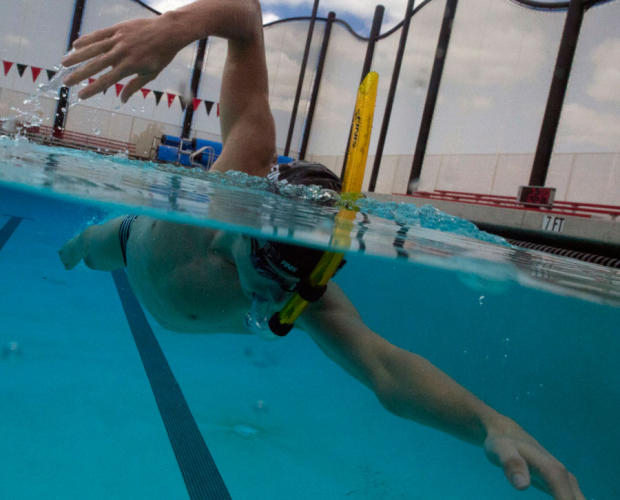Surviving and Prevailing in Open Water
Here is what a Slowtwitcher wrote on our Reader Forum recently:
“I started swimming freestyle a few years back having never really learned as a child so it is all still a bit unnatural and new to me. I'm able to swim 750-meters-plus in a pool nonstop (not particularly fast but can do it) but seem to get a barrier to swimming nonstop in an open water environment and have to stop after 100 or 200 meters and breast stroke for a minute, compose myself, and start again.“
People get themselves in trouble when they panic, and they panic when their counterfactual fears overwhelm all their accumulated knowledge, and their demonstrated competence.
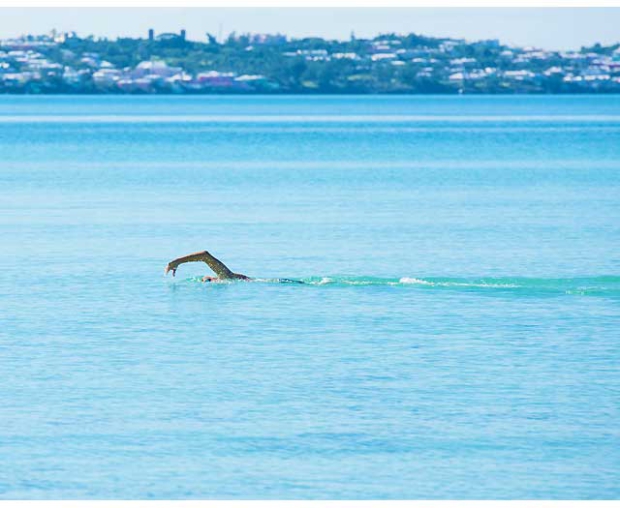
Let's list some of those fears, see if we can dismantle the scaffolding that upholds our fears, and once we've dealt with our fears let's talk about how to make the open water a joyous place and a strategically advantageous race environment.
I can’t see the bottom!
This might seem trivial to you, but a lot of AOS (Adult Onset Swimmers), and even those who came to triathlon as pool swimmers, discover only during a race that this is the first time they haven't seen the bottom. I can't imagine being troubled by the inability to see the bottom during a race. But I've been unable to see what's below me for 55 years, so, that disorientation caused by not knowing what's beneath you is foreign even to my imagination. But if this describes you, know this: it's abated by acclimation. As you spend time in the open water, you become inured to this.
I can’t believe I’m this far from safety!
The race may also be the first time you've been more than 12 and-a-half yards from dry land. I could imagine it's a little freaky to stop swimming, look back at the shore, and see it so…. far… away! In fact, in most races you're almost never more than a few minutes swimming from shore. You can tread water, or float on your back, for many hours. You have proven to yourself in the pool that, muscularly, you can easily swim for well over an hour. You've developed a skill resume that amply demonstrates that you are in no danger when you're a few hundred yards from shore, but having that knowledge in your conscious brain does not always translate to the fear that sits down on your brain stem. So… this is another case where acclimation inoculates you from the brain stem fears that might pop up during a swim.
It’s bumpy out here!
Open water is also the only time you're likely to experience swells or bumpy water – you’re not going to get choppy water in a pool with lane lines. I’ve been in the open water thousands of times, and that includes very choppy water. I’ve never encountered chop that a reasonably executed freestyle stroke can’t handle.
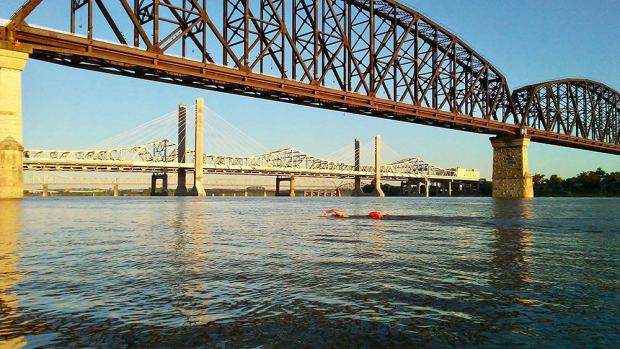
There are sea creatures!
Yes. Land creatures too! If you go running or mountain biking in the woods there are mountain lions. However, the rate at which nature revolts is infinitesimally small, so as to approach zero. I could go through the statistics, but you know them. This is part of that calculus, where you need to make a decision. I've spoken to many people who know their fears are irrational, yet choose to remain imprisoned by them. I can’t help you with this. I can only tell you that I chose to explore the wild and beautiful places – both on and off shore – and the wager has paid off for me.
That water is cold! If you are in a competition pool heated to a competition temperature, you’re swimming in 79° F water. You’re probably swimming in 81° to 83° water because most community pools serve a number of needs, which include water therapy, water yoga, recreational swim and the like, and low-80s is the détente that all community pool swimmers uneasily agree to live with. I swam an open water race last week, and the water was 61°. Did it bother me? No. But it was nothing like the pool I swim in. It can be unnerving to immerse yourself in very different water than what you’re used to, if that experience is new to you.
That water tastes funny! You know when you go to someone’s how for a visit, and that house smells different than yours? In fact, your house doesn’t have a smell. To you! But it does to others. Pool water has a taste, you just don’t know what that taste is, because it’s like your home – that taste is the neutral taste that you can’t perceive. Open water is like someone else's home. When I did that open water race I refer to just above, it was in the ocean and I could smell the brine, and the mussels attached to pier pylons. When I was younger, growing up in Huntington Beach, California, one could taste the oil in the water, from time to time. (Less so now.) Rivers and lakes have their tastes, and when you swim open water all your senses – texture, taste, smell, sight, and even sound – are triggered.
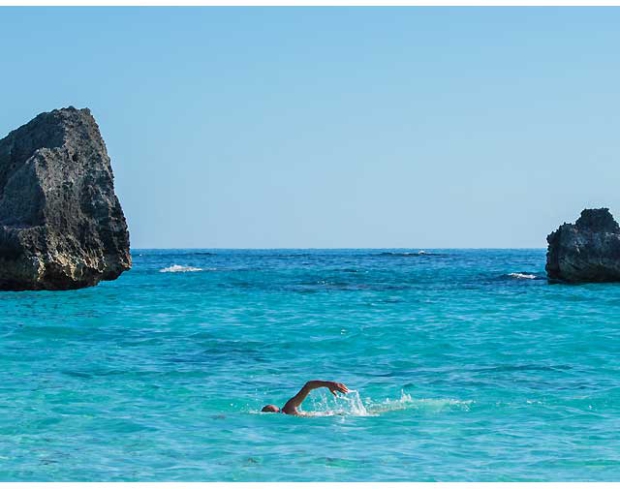
Equipping yourself
The thing about life rafts, as long as they hold air they are pretty much impossible to sink. You can place a human in a life raft in the middle of a squall and there is almost no danger. You are like that life raft. It is almost impossible to sink a human, if that human has even just basic open water familiarity. You have the capacity to endure tides, swells, chop, and a significant distance from shore. But you are actually more than a life raft. As inflatable boats go, you’re more like a Zodiac. It almost doesn’t matter how angry the sea, human swimmers have the capacity not just to survive and prevail, but they have a pretty decent propulsion system.
Of course all that is cognitive. It’s hard to abate the brain-stemmy fears with classroom education. Irrational fear is fear nevertheless. If you're not made eager, but fearful, of the majesty and enormity of open water, what can you do?
First, of course, is to (as they say) dip your toe in the water. Just, in this case the open water (assuming you're able to swim a decent distance, with decent competence, in the pool). You will solve a lot of the line item fears above just by getting in the open water and swimming. If you live in an area populated by triathletes, there are probably open water swim sessions proximate to you. You will need to ask around. Ask members of the local triathlon club. Call up local race directors. Just keep calling and asking. Or place a post on our Reader Forum, tell us where you're at, and ask.
The wall is a rest:
Every 25 yards or 25 meters or 50 meters you get a rest. You may not think so, but, every time you stop, touch the wall, and go, that's a little bit of a rest for your arms, and that's the case even if you're turning as fast as you can. This is why it's good practice to learn how to flip turn (even if you turn badly, and you certainly will for a while.) Even when you flip turn you do get a little bit of a break from pulling water, but the break is shorter than if you "open" turn (or else good swimmers wouldn't flip turn), and that muscular break is offset by the hypoxic nature of the flip turn. Accordingly, at some point, you'll want to suck it up and learn this skill.

Learn to sight: Practice sighting when you swim. I look up once every 12 or 15 strokes, unless I’m attached to some fast swimmer’s feet (drafting him or her), in which case maybe now it’s once every 50 strokes. Learn to sight without breaking your stroke cadence.
Think about your goggles: Triathlons take place in the morning, and you may find yourself looking right into the rising sun during your swim. My favorite lens for almost all conditions is ROKA’s Dark Amber. However, You may want to consider something like a Light Amber to have in your swim bag, in case you’re on a low-light condition. June Gloom out on the Pacific Coast? In the early morning? No rising sun to consider? Light Amber. But if it’s very bright, Dark Amber.
Fix your pull to the right (left): You won’t know if your swim stroke arcs you to the right or left until you swim in open water. That line at the bottom of the pool keeps you straight. If you arc to one side when you swim in the open water, it is almost certainly going to be the side you breathe on. We’ll have plenty to write about soon on how to fix that.
Spectate the tides and currents; ask the lifeguards: Here is what I pray for when I race: huge waves, big side currents, rip currents. Anything that freaks out my competitors; or that take my competitors by surprise because they just haven't thought to notice or to ask. We hear about the “deadly rip currents” that occur at the beach. Why are they deadly? Because they sweep riders out to sea. That open water race I did last week, I was one of the few people to recognize and swim directly out through a rip current. It was like swimming on one of those people movers that take you from terminal to terminal in an airport. If there’s a side current, fine, then it becomes a geometry problem. If you look at the ocean (or river), look at whether the foam on the surface is moving, ask the local lifeguards, then challenging conditions became things you want, not a thing you avoid.
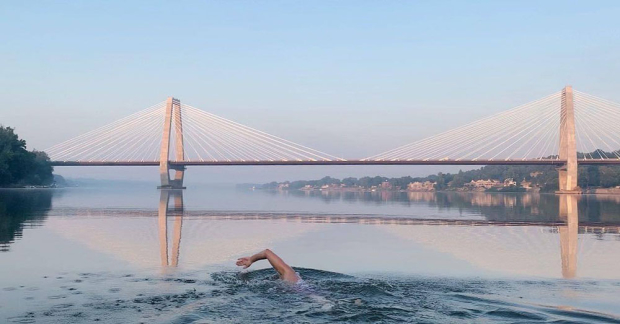
When racing
In a race, start at the side: I don’t know about you, but I find mud wrestling and open water swimming incompatible activities, when engaged in simultaneously. The easiest way to make sure you don’t find yourself in a group mud-wrestle in the middle of the swim is to not be in the middle of the swim. Start at the edge of the swim. I’m a pretty good swimmer, and that’s what I do. If you’re watching the track & field Olympic Trials (in any country) what you’re likely to see is a mad sprint for the first 100 meters, regardless of distance, from 1,500 meters to 10,000 meters. For some reason these athletes consider it really important to get into the right spot right away, and then they settle into their actual, real pace. It’s just like that in an open water swim. Even if you’re faster than 90 percent of the swimmers in a wave, 50 percent of those swimmers will swim faster than you want to over the first 200 meters, and that means it’ll be a scrum. Just swim to the side of that scrum before you slot into a stream of swimmers as that blob becomes a thin line. Best, if you can, to have that blob visible to you, so, I generally prefer to line up on the right edge of the start line, because I’m a left-side breather.
Become a competent tactical breather: Okay, this is advanced. But it’s not physically hard. It doesn’t take athleticism you don’t have. What I’m talking about is the ability to take consecutive breaths. I write about this here, and will write about it again soon. As with flip turns, it’s just a case of practice. I find that the capacity to breathe on both sides, and to not only breathe on the unnatural side, but to take a consecutive breath, greatly opens up my capacity to prevail in the open water. This is a big deal when you’re around other swimmers, because you’re going to lose a breath now and then, and the ability just to take an immediate breath on the other side is huge. You’ll also find that it’s convenient to breath on both sides when there’s a swell or a chop that hits you on your normal breathing side; and when you need to sight other swimmers, to make sure you’re not swimming to Easter Island while everyone else is making for the orange buoy.
Warm up: Unless it’s just not possible, I do a nice long warm up in the water before I race. If it’s not possible, I do some sort of warm up on land, to get my heart going. During the warm up, if you swim back the way you swim out, then I swim out and stop and look back at the finish, so that I can see what it is I’m sighting as I’m swimming toward the finish.
Every swimmer is either better or worse in the open water swimmer than he or she swims in the pool. Which will you be? A lot of that is just a decision you make and at the risk of sounding annoyingly new age, you almost just need to speak it into existence. Making friends with open water, getting to know it, is a decision before it is anything else. The cognitive you must demonstrate to the guttural, reflexive you that the open water is not a threat, and you do that by engaging the open water in a safe environment, with others, not biting off more than you can chew. Once your fears abate, or become manageable, once you feel that you belong in the open water, then you’re not on the defensive. You can begin to control the process. You can learn to navigate the surf; to draft swimmers in the open water; to use currents to your advantage.


